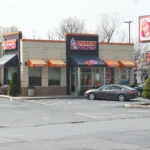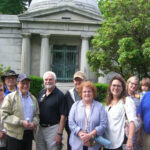“It’s like a completely new ballpark, one that’s among the best in minor league baseball.”
— RailRiders fan Phil Bosha, of Wyoming
 The date: April 4, 2013
The date: April 4, 2013
The place: PNC Field
The situation: After a year away from the area while their stadium underwent a major facelift and significant rebranding, baseball was back on Montage Mountain.
The Yankees were gone. The RailRiders were here.
The old structure once beloved as Lackawanna County Stadium also was history. State-of-the-art PNC Field was here.
The 2013 season was getting under way, as the RailRiders hosted Pawtucket in their first-ever game. But few moments in team history provided as clear a line of demarcation between the past and the future as this one, and everyone who walked through the gates that chilly night knew it.
The lead-in: The Yankees’ Triple-A team wasn’t going to play in PNC Field, as it stood in 2007, for very long. That much is clear.
In November of 2007, then-Lackawanna County commissioner Robert Cordaro — years before he was convicted on corruption charges and sentenced to 11 years in a federal prison in 2012 — announced he offered the Yankees a new stadium on the site of the old one as part of the agreement to move their Triple-A operation to Moosic in 2007.
By the summer of 2008, officials from Mandalay Baseball Properties — the group managing the team’s day-to-day operations at the time — informed the Lackawanna County Stadium Authority that their “ultimate goal” was to get a new stadium built on the site. The cost, they estimated, would rank somewhere between $35 million and $50 million.
Both sides said there was “no commitment” between the county and Mandalay that a new stadium would be built, only that it was a worthwhile endeavor to work toward. With no state funding guaranteed and no other funding source mentioned, thoughts of a new stadium simmered for years on the back burner.
Mandalay official continued to push for a new ballpark, though, pointing out perceived deficiencies at the stadium. Many of them, they said in the summer of 2008, were structural and electrical in nature. In June of 2009, a study of the stadium by national firm Ewing Cole found that while the then-20-year-old stadium was in “relatively good condition,” it still needed upward of $13 million in repairs to stay functional beyond the 2011 season.
A month later, a failure of the drainage system on the field forced the postponement of several games on otherwise beautiful days at PNC Field. Home games were moved to other sites around the IL North. (More on that later.)
In 2010, then-Pennsylvania Gov. Ed Rendell confirmed he supported the sale of the franchise to a group led by the New York Yankees and Mandalay Baseball Properties, and later in the year, he committed to state funding that could be put toward an investment in the stadium. Just days later, the county announced it agreed to sell the franchise for $14.6 million, which included both a 30-year lease and a $40-million renovation of the stadium.

An artist’s rendering of plans for a renovated PNC Field, 2010.
Then-county commissioner Corey O’Brien said the agreement was neither the politically expedient or easy decision to make. But with the cost of repairs exceeding the county’s ability to keep up with growing finances needed to keep the park up to date enough, officials feared the future of professional baseball in northeast Pennsylvania was at stake.
“That is the hand we have been dealt,” O’Brien said, “and we need to play it in a responsible way.”
Gov. Tom Corbett approved $20 million in state grants to go toward the project, and team officials announced the renovation would begin after the 2011 season, forcing the Scranton/Wilkes-Barre Yankees to play all 72 of their home games in 2012 on the road, mostly in upstate New York locales like Rochester, Syracuse, Buffalo and Batavia. For one season, they were renamed the “Empire State Yankees.”
The moment: Publicly anyway, team officials said costs for the stadium renovation exceeded $43 million by the time PNC Field reopened in time for the season opener against Pawtucket in 2013.

Hall of Famer REGGIE JACKSON throws out the first-ever pitch at PNC Field. Jason Farmer/Staff Photographer
It provided fans with their first look at the new stadium, which now included expanded luxury boxes, a new club seating area, bar seating in right field, a new picnic area in left field, a walkway around the stadium that would allow fans to walk around the park during the game with clear views of what’s going on on the field, an expanded kids’ play area, a giant video board, lawn seating that spanned most of the right- and right-center field areas beyond the fence and, perhaps most dramatically for longtime Scranton/Wilkes-Barre fans, no upper deck.
“This stadium is like a B-12 shot for the people of Lackawanna County,” Lackawanna County Commissioner Pat O’Malley said. “It offers entertainment for everyone from a child to grandparents. … I have no problem saying this is the best ballpark in Minor League Baseball.”
It was a bit of a rough-around-the-edges night. Work was being completed in the press box until just a few minutes before first pitch. Statistics weren’t always correct on the scoreboard. Seat assignments were changed the day of the game for some fans who bought tickets ahead of time. The public address system needed some in-game tweaking, too.
Oh, and the RailRiders didn’t win. The RailRiders scored two runs in the first inning, but Pawtucket rallied to tie. In the 10th inning, a majestic home run by Pawtucket’s Jeremy Hazlebaker started a five-run inning that pushed the Red Sox to an 8-5 win.
But fans got their first look at a ballpark that would become the centerpiece of area sports, a stadium that still ranks six years after its opening as one of the most sparkling venues in the International League and all of minor league baseball.
HISTORY BEHIND THE MOMENT
 Rob Crain, during his days as team president and general manager, became fond of calling PNC Field “the area’s front porch.” He envisioned, he said, the facility being more than just a baseball venue.
Rob Crain, during his days as team president and general manager, became fond of calling PNC Field “the area’s front porch.” He envisioned, he said, the facility being more than just a baseball venue.
Of course, it has mostly been a baseball venue since its renovation. It held the 2017 Triple-A National Championship Game, hosted all five games of the 2018 Governors’ Cup Finals and will host the 2020 Triple-A All-Star Game. Under former general manager Jeremy Ruby, the team brought an annual high school football game — known as the RailRiders Bowl — to the ballpark, and Memorial Day weekends

Office star STEVE CARRELL‘s return marked the highlight of The Office Wrap Party at PNC Field. TIMES SHAMROCK PHOTO
have been reserved for PIAA District 2 high school baseball championship games at the ballpark.
Perhaps the most anticipated event in the renovated park’s history, though, wasn’t a sporting event at all. On May 4, 2013, just a few weeks before the popular Scranton-centric sitcom aired its finale, PNC Field hosted “The Office Wrap Party,” drawing thousands to the stadium to cap a day in which the show’s stars came back to the area to thank The Electric City for its support.

Donnie Collins has been a member of The Times-Tribune sports staff for nearly 20 years and has been the Penn State football beat writer for Times-Shamrock Newspapers since 2004. The Penn State Football Blog covers Nittany Lions, Big Ten and big-time college football news from Beaver Stadium to the practice field, the bowl game to National Letter of Intent Signing Day. Contact: dcollins@timesshamrock.com; 570-348-9100 x5368; @DonnieCollinsTT



